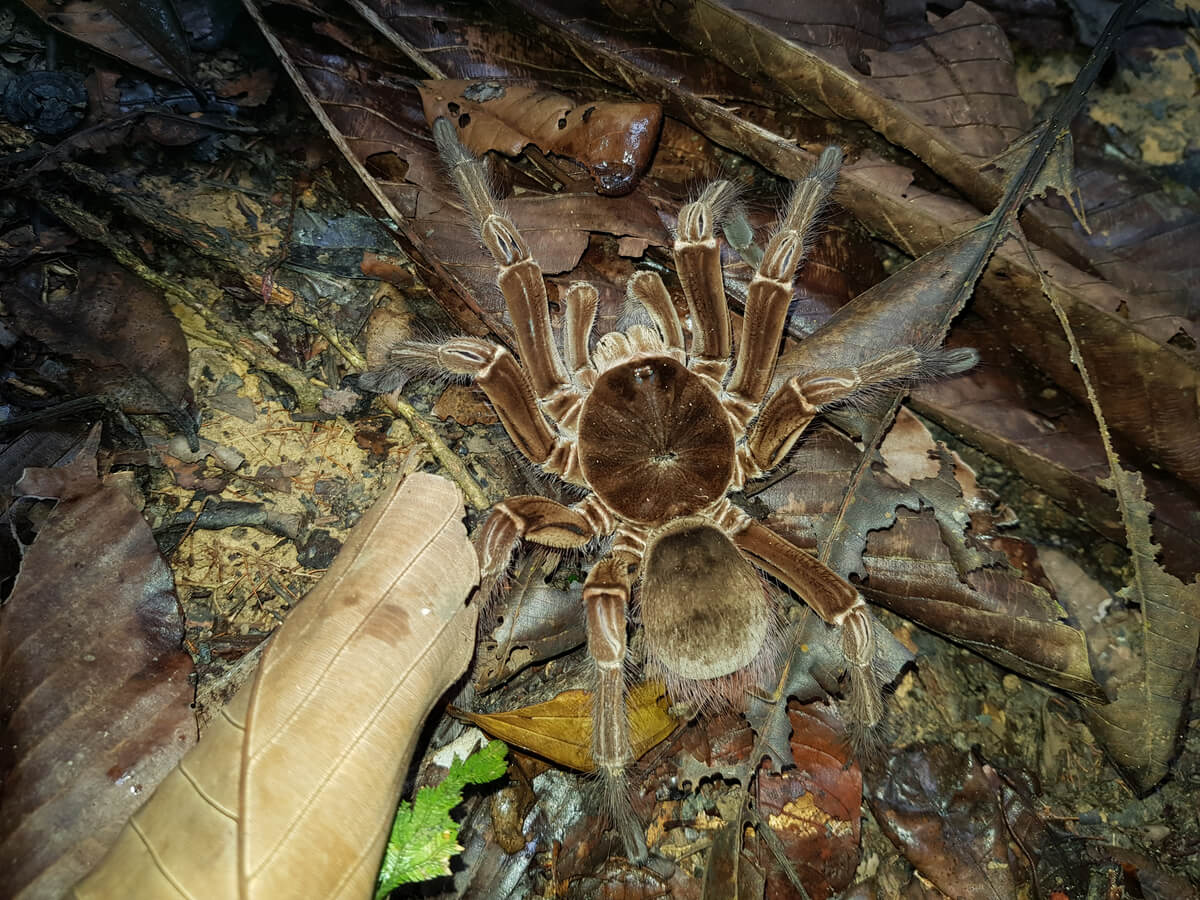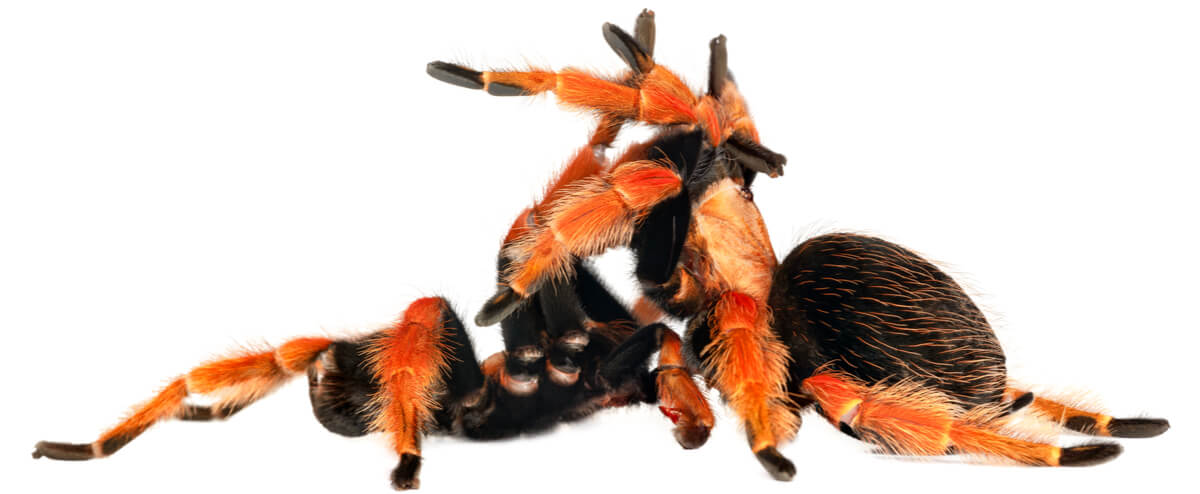10 Curiosities About Tarantulas


Written and verified by the biologist Samuel Sanchez
Invertebrates with eight legs aren’t usually admired by too many people, especially if we factor in their sharp fangs and their ability to inject venom. Arachnids have a reputation based on fear, and some people even have a real phobia of them. If you’re scared of spiders, then getting to know these 10 curiosities about tarantulas will help you relieve your fear.
Tarantulas are usually gentle, calm beings that don’t attack unless the insistence of the aggressor persists for a long time. Get ready to lose your fear with us: we assure you that these hairy invertebrates will surprise you for good.
1. There are many species of tarantulas
The term “tarantula” usually refers to a large, black or brown arachnid with many hairs. Although this describes some of the most common species (Grammostola rosea, Lasiodora parahybana or Brachypelma vagans), the reality is that there are many representatives within this group.
In fact, when we talk about tarantulas we’re referring to the Theraphosidae family, a group of arachnids that are very similar to each other, comprising about 1010 species divided into more than 124 genera, as studies indicate. Interestingly, in Europe, wolf spiders (Lycosidae) are called “tarantulas”, but they aren’t part of the teraphoside taxon.
Some species are known as “false tarantulas”, due to their resemblance to the real ones.
2. Curiosities about tarantulas: a common body shape
Like all arthropods, tarantulas have an exoskeleton that serves as an insulator against the external environment and allows muscle insertion. In addition, the body is divided into 2 well-differentiated tagmas: the cephalothorax (prosoma) and the abdomen (opistosoma). In the prosoma there are 6 pairs of appendages: a pair of chelicerae (fangs), a pair of pedipalps, and 4 pairs of motor legs.
The size and coloration of the world’s tarantulas vary widely. For example, the Neoholothele incei species usually doesn’t measure more than 7 centimeters (nearly 3 inches) in diameter from leg to leg, while the Goliath tarantula (Theraphosa blondi) easily reaches 30 centimeters from end to end.
Tarantula colors are typically muted, but some species feature gorgeous metallic whites, grays, oranges, and blues.

3. An uneven distribution
Tarantulas are divided according to their distribution into two groups: New World and Old World. The first term refers to the American continent, while the Old World includes endemic species from Africa and Asia. As a general rule, Old World tarantulas are much faster and more aggressive, probably because of the environmental pressures they have to face.
Although it seems unlikely, the occasional species is found in Europe, beyond the arid areas of Africa and the humid forests of Asia and South America. Ischnocolus valentinus is the only species of teraphoside that can be found in Spain and Italy, for example.
4. Poisonous, but to what extent?
All tarantulas are poisonous to a greater or lesser extent, as they have sharp chelicerae that connect to toxin-producing glands. Most species resident in the United States and Latin America don’t produce very powerful poisons, but Asian and African species can cause a fair few problems.
An example of one is the Heteroscodra maculata, a species native to West Africa with a beautiful white hue, but a very bad temper. According to personal reports, the bite of this species can cause blurred vision, palpitations, very obvious pain and other general signs.
No species of tarantula has a venom powerful enough to kill a human. Most New World species sting with wasp-like intensity.
5. Tarantulas have a low metabolic rate
Tarantulas are ectothermic animals. As such, they depend on the environment to control their internal temperature, something that greatly limits their movements and available energy. For this reason, they have exceptionally low metabolic rates and rarely leave their dens. An adult specimen can go from 6 months to 2 years without eating.
Tarantulas have higher metabolic rates when the general temperature increases and they eat more regularly.
6. Curiosities about tarantulas: they live in dens
Linked to the previous point, one of the most striking characteristics about tarantulas is that they spend the vast majority of their time in their dens. This can be a hole of varying depths in the ground, in a pit, or a hole in a trunk or tree in arboreal spiders. These arachnids fill their hiding places with their webs to perceive the vibrations of the external environment and act accordingly.
All species of tarantula produce webs, whether arboreal or terrestrial.
7. Patient and calm predators
Like other arachnids, tarantulas are strict carnivores. This means that they feed exclusively on living beings, be they insects, worms, other arachnids, small vertebrates, amphibians, and even birds. Larger species can cope with juicier prey, more because of the size of their chelicerae (up to 4 centimeters) than because of their venom.
Because they’re animals with a very low metabolism, tarantulas don’t actively chase their prey. They wait for patients in their lair and, when they perceive the vibrations of possible prey, they pounce on them and immobilize them with their fangs and poison. The toxins and juices released dissolve the victim’s tissue, as these arachnids can only consume liquid food.
8. Tarantulas are quite vulnerable
Although they’re predatory and have enviable fangs, one of the curiosities about tarantulas is that they go through a very vulnerable period, known as molting or ecdysis. In it, they must completely shed their external exoskeleton in order to continue growing, a process that can take hours and which leaves the animal defenseless.
Before molting, tarantulas stop eating for varying lengths of time, even up to 2 weeks. Thus, they prevent their abdomen from growing so large that it gets stuck in their old exoskeleton. When they’re ready, they go into their shelter, cover it with dirt and lie down to molt.
It takes several hours for the “new” exoskeleton to begin to harden. In this period, the tarantula is very vulnerable. Have a look at this video!
9. Curiosities about tarantulas: the drums of love
As archaic as they may seem on an evolutionary level, tarantulas have a really fascinating way of reproducing. When an adult male meets a female, she begins to perform a movement with the pedipalps known as “drumming.” The vibrations warn the female that a suitor is near her lair, so she goes out to observe him.
This process is very delicate, as the male has to rub his modified pedipalps (previously covered in semen) with a specialized structure of the female in the abdomen. The position the male adopts is one of complete vulnerability, and, in many cases, it ends up becoming the snack of his female suitor.

10. Tarantulas can be kept as pets!
It’s becoming more and more common to see people who love exotic animals launching themselves into the world of tarantulas as pets. They’re easy arachnids to care for, as they can be housed in small terrariums (20 centimeters – 8 inches – long, wide and generally high for an adult), their venom isn’t too potent, and they have a lot of environmental variability.
However, it should be noted that not all species are easy to care for and that females can live up to 15 years. As always when adopting a pet, owning a tarantula is a long-term responsibility that every owner must factor in before obtaining a specimen.
All cited sources were thoroughly reviewed by our team to ensure their quality, reliability, currency, and validity. The bibliography of this article was considered reliable and of academic or scientific accuracy.
- Wilson, D. M. (1967). Stepping patterns in tarantula spiders. Journal of Experimental Biology, 47(1), 133-151.
- Dor, A., & Hénaut, Y. (2012). Silk use and spiderling behavior in the tarantula Brachypelma vagans (Araneae: Theraphosidae). Acta zoológica mexicana, 28(1), 1-12.
- Ferretti, N. E., & Ferrero, A. A. (2008). Courtship and mating behavior of Grammostola schulzei (Schmidt 1994)(Araneae, Theraphosidae), a burrowing tarantula from Argentina. The Journal of Arachnology, 36(2), 480-483.
- Blatchford, R., Walker, S., & Marshall, S. (2011). A Phylogeny‐Based Comparison of Tarantula Spider Anti‐Predator Behavior Reveals Correlation of Morphology and Behavior. Ethology, 117(6), 473-479.
This text is provided for informational purposes only and does not replace consultation with a professional. If in doubt, consult your specialist.